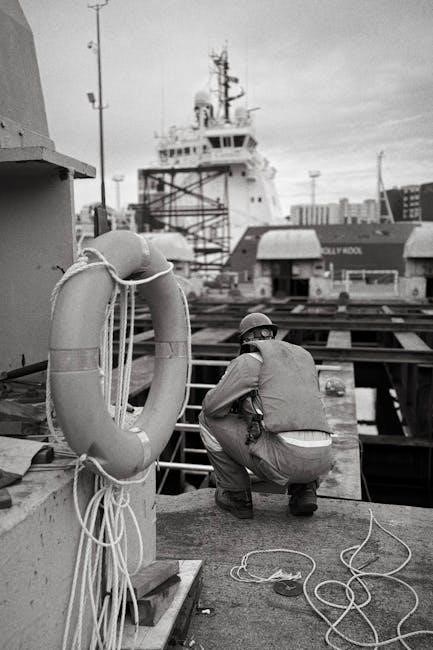
The Navy 3M Manual, issued by Naval Sea Systems Command, provides guidance for maintenance and material management, ensuring effective operations, safety, and standardization across naval vessels and equipment․
Overview of the 3M System
The Navy 3M System, outlined in the Ships Maintenance and Material Management (3-M) Manual, is a comprehensive framework designed to ensure the readiness, safety, and efficiency of naval vessels and equipment․ It integrates Planned Maintenance System (PMS) with material management practices, providing standardized procedures for maintenance, inspections, and repairs․ The system emphasizes proactive maintenance to prevent equipment failures and reduce downtime․ It also establishes clear roles and responsibilities for personnel involved in maintenance activities, ensuring accountability and adherence to established protocols․ By leveraging the 3M System, the Navy maintains operational readiness while optimizing resource utilization and ensuring compliance with safety and operational standards․
Importance of Maintenance and Material Management in the Navy
Maintenance and material management are critical to the Navy’s operational readiness and mission success․ Effective maintenance ensures that ships, submarines, and equipment remain functional and reliable, while material management guarantees the availability of necessary supplies and parts․ Properly executed, these practices prevent equipment failures, reduce downtime, and enhance safety for personnel․ Additionally, they contribute to cost savings by optimizing resource use and extending the service life of assets․ Compliance with these practices, as outlined in the 3M Manual, is essential for maintaining the Navy’s capability to respond to operational demands effectively․ By prioritizing these processes, the Navy ensures its fleet remains prepared to meet strategic objectives and protect national interests․

Key Components of the Navy 3M Manual
The manual outlines core elements such as maintenance procedures, material management protocols, and compliance standards to ensure operational readiness and efficiency across naval operations․
Purpose and Scope of the Manual
The Navy 3M Manual is designed to establish standardized procedures for maintenance and material management across naval operations․ Its primary purpose is to ensure operational readiness, safety, and cost-effectiveness by providing clear guidelines for personnel․ The manual applies to all Navy ships, submarines, and shore-based activities, outlining responsibilities for maintenance, inspections, and repairs․ It emphasizes preventive maintenance to reduce equipment downtime and extends the lifespan of naval assets․ The scope includes detailed procedures for recording maintenance activities, managing spare parts, and ensuring compliance with safety standards․ By adhering to the manual, personnel can maintain equipment reliability, reduce operational risks, and support mission success․ The manual is a critical resource for achieving these goals effectively․
Roles and Responsibilities in the 3M Program
The Navy 3M Program outlines specific roles and responsibilities to ensure effective maintenance and material management․ Commanding Officers are ultimately responsible for implementing the program and ensuring compliance with manual guidelines․ Maintenance Managers oversee the execution of maintenance activities, coordinating schedules and resources․ Quality Assurance Supervisors verify that all work meets standards and procedures․ Senior Enlisted Leaders provide guidance and oversight to junior personnel․ Maintenance Personnel perform routine inspections, repairs, and preventive maintenance tasks․ Each role ensures the program operates efficiently, maintaining naval readiness and safety․ Clear responsibilities promote accountability and coordination, enabling the Navy to achieve its operational goals effectively․

Planned Maintenance System (PMS) Implementation
The Navy 3M Manual provides a structured approach to implementing PMS, ensuring regular inspections, scheduled maintenance, and compliance with established guidelines to maintain operational readiness and safety․
Procedures for PMS Execution
The Navy 3M Manual outlines detailed procedures for executing the Planned Maintenance System (PMS), ensuring that all maintenance activities are conducted systematically and efficiently․ These procedures include scheduling routine inspections, performing preventive maintenance tasks, and documenting all actions taken․ Personnel are required to follow standardized checklists and guidelines to ensure consistency and compliance with safety protocols․ The manual also emphasizes the importance of timely completion of maintenance tasks to avoid operational delays․ Additionally, it provides procedures for reporting defects, managing spare parts, and conducting post-maintenance inspections to verify readiness․ By adhering to these procedures, the Navy ensures that equipment and systems remain operational, reducing the risk of unforeseen failures and enhancing overall fleet readiness․
Roles of Personnel in PMS
In the Navy 3M Manual, the Planned Maintenance System (PMS) relies on clearly defined roles for personnel to ensure effective execution․ Maintenance officers are responsible for overseeing the entire PMS program, ensuring compliance with procedures and scheduling․ Supervisors coordinate daily maintenance tasks, assign responsibilities, and review completed work for quality assurance․ Technicians perform hands-on maintenance, document actions, and report any issues or discrepancies․ Additionally, quality assurance personnel conduct inspections to verify adherence to standards․ Each role is critical to maintaining equipment readiness and operational safety․ Clear communication and collaboration among personnel are essential to the success of the PMS, ensuring that all tasks are completed efficiently and effectively․ Proper role assignment and accountability are emphasized to prevent oversight and ensure seamless operations․

Maintenance and Material Management (3-M) Program
The Navy 3M Manual outlines the Maintenance and Material Management Program, ensuring efficient maintenance and material practices․ It integrates scheduling, record-keeping, and material management to optimize fleet readiness and resource utilization․
Definitions and Terminology
The Navy 3M Manual includes specific definitions to ensure clarity and consistency in maintenance and material management․ Key terms include Planned Maintenance System (PMS), which refers to scheduled maintenance tasks to prevent equipment failure․ Material Readiness is the ability to sustain operations with available resources․ Maintenance Requirement Cards (MRCs) outline specific tasks and intervals for equipment upkeep․ Work Center Supervisor is responsible for overseeing maintenance activities․ These definitions standardize processes, ensuring personnel understand their roles and responsibilities․ Proper terminology usage is critical for effective communication and compliance with the manual’s guidelines․ Understanding these terms is essential for implementing the 3M Program efficiently and safely across naval operations․
Procedures for Effective Maintenance
Effective maintenance under the Navy 3M Manual involves structured procedures to ensure equipment reliability and operational readiness․ Pre-maintenance checks include inspecting equipment, reviewing maintenance history, and gathering necessary tools․ During execution, technicians follow detailed work instructions and adhere to safety protocols․ Corrective maintenance addresses unexpected failures, requiring prompt identification and resolution․ Preventative maintenance is scheduled based on usage or time intervals to prevent breakdowns․ Documentation of all maintenance actions is critical for tracking and future planning․ Post-maintenance reviews ensure tasks are completed correctly and identify areas for improvement․ These procedures minimize downtime, reduce costs, and enhance overall fleet readiness, aligning with the Navy’s mission requirements․ Proper adherence ensures seamless operations and safety across all naval assets․

Compliance and Adherence to the 3M Manual
Compliance with the Navy 3M Manual is critical for ensuring safety, efficiency, and operational readiness․ Adherence guarantees standardized procedures, reducing risks and maintaining fleet capabilities․ Non-compliance risks safety hazards and inefficiency․
Importance of Compliance in Naval Operations
Compliance with the Navy 3M Manual is vital for ensuring safety, efficiency, and operational readiness․ It guarantees that all maintenance and material management activities align with established standards, minimizing risks and ensuring fleet reliability․ By adhering to the manual, personnel can prevent equipment failures, reduce downtime, and maintain mission readiness․ Compliance also promotes standardized procedures, fostering consistency across commands and reducing errors․ Moreover, it ensures that resources are used effectively, supporting cost management and sustainability․ Ultimately, compliance is essential for upholding the Navy’s operational integrity and achieving strategic objectives․
Consequences of Non-Compliance
Non-compliance with the Navy 3M Manual can lead to severe repercussions, including equipment failure, safety hazards, and operational inefficiencies․ Without adherence to established protocols, maintenance standards may decline, increasing the risk of accidents and compromising mission readiness․ Non-compliance can result in disciplinary actions, as it undermines accountability and operational integrity․ Additionally, it may lead to financial losses due to premature equipment degradation or the need for costly repairs․ In extreme cases, non-compliance can jeopardize national security by impairing the Navy’s ability to execute critical tasks effectively․ Therefore, adhering to the 3M Manual is essential to avoid these adverse outcomes and maintain the Navy’s operational excellence․

Updates and Revisions to the 3M Manual
The Navy 3M Manual undergoes periodic updates to ensure alignment with evolving technologies and operational needs․ Revisions incorporate lessons learned and stakeholder feedback, maintaining its effectiveness․
Recent Changes and Revisions
Recent updates to the Navy 3M Manual focus on improving efficiency, safety, and compliance․ These revisions include enhanced guidance on predictive maintenance, digitized work processes, and integrated logistics support․ New sections emphasize the use of advanced data analytics to optimize maintenance schedules and reduce downtime․ Additionally, updates address cybersecurity measures to protect sensitive maintenance systems from potential threats․ The revisions also streamline procedures for reporting and tracking maintenance activities, ensuring better accountability and transparency․ These changes reflect the Navy’s commitment to adapting to modern technological advancements while maintaining operational readiness․ By incorporating feedback from fleet operations, the manual remains a critical resource for effective maintenance and material management․
How to Stay Informed About Updates
To stay informed about updates to the Navy 3M Manual, personnel should regularly check official Navy publications and bulletins․ The Navy issues periodic updates through official channels, including the Navy Knowledge Online (NKO) portal and command-specific notifications․ Additionally, subscribing to email alerts from the Naval Sea Systems Command (NAVSEA) ensures timely notifications of revisions․ Personnel can also attend mandatory training sessions and workshops conducted by their commands, which often cover recent changes to the manual․ Participating in fleet-wide forums and discussions can provide insights into how updates are being implemented․ Finally, reviewing the manual periodically and cross-referencing with the latest revision dates helps ensure compliance and awareness of new procedures․

Best Practices for Implementing the 3M Manual
Implementing the Navy 3M Manual requires standardized procedures, regular audits, and clear communication․ Continuous training, teamwork, and adherence to established protocols ensure effective and efficient maintenance operations․
Training and Certification for Personnel

Effective implementation of the Navy 3M Manual requires comprehensive training and certification for all personnel involved․ Training programs should align with the manual’s standards and regulations, ensuring personnel understand maintenance procedures, safety protocols, and documentation requirements․ Initial training should cover foundational concepts, while recurrent training reinforces best practices and addresses updates․ Hands-on training sessions and computer-based modules are essential for practical application․ Certification ensures personnel demonstrate proficiency in specific tasks, such as equipment inspections and repair procedures․ Supervisors must verify that all team members meet certification criteria before assigning critical tasks․ Regular reassessment and continuous learning opportunities help maintain expertise and adapt to evolving maintenance demands․ Properly trained and certified personnel are key to achieving operational readiness and safety in naval operations․
Tools and Resources for Effective Implementation
Successful implementation of the Navy 3M Manual relies on the use of specialized tools and resources․ Digital tools, such as Computerized Maintenance Management Systems (CMMS), enable efficient tracking and scheduling of maintenance tasks․ Diagnostic equipment, like multi-meter devices and thermal imaging cameras, assists in identifying potential issues before they escalate․ Technical manuals, diagrams, and standard operating procedures provide clear guidance for personnel․ Additionally, online platforms and software solutions facilitate real-time data sharing and collaboration among teams․ Training simulators and virtual reality tools enhance hands-on learning experiences․ Regular updates to these resources ensure alignment with evolving technologies and operational demands․ Access to these tools empowers personnel to perform tasks accurately and efficiently, ensuring the 3M Manual’s objectives are met effectively․

Case Studies and Real-World Applications
The Navy 3M Manual has transformed maintenance practices, as seen in a destroyer’s successful implementation, achieving 98% operational readiness by streamlining procedures and reducing downtime significantly․
Success Stories in Naval Maintenance
The Navy 3M Manual has enabled significant advancements in fleet readiness․ For instance, the USS Arleigh Burke achieved a 25% reduction in maintenance downtime by implementing 3M procedures․ This success was attributed to streamlined work orders and improved material tracking, ensuring critical systems remained operational during deployment․
Another notable example is the USS Nimitz, which reported a 30% increase in operational availability after adopting the 3M system․ By integrating preventive maintenance schedules and leveraging real-time data, the crew minimized unexpected repairs and enhanced overall performance․ These success stories highlight the manual’s effectiveness in modern naval operations․
Lessons Learned from Past Experiences
The Navy 3M Manual has evolved based on lessons learned from past challenges․ One key takeaway was the importance of timely inspection cycles․ For example, the USS Independence experienced equipment failures due to overdue inspections, highlighting the need for stricter adherence to scheduled maintenance․ This led to the implementation of more rigorous tracking and accountability measures․
Another lesson emerged from delays in spare parts procurement․ The USS Ronald Reagan faced operational setbacks due to inefficient supply chain processes․ To address this, the 3M Manual now emphasizes enhanced communication between maintenance and logistics teams․ These experiences underscore the manual’s adaptability and its critical role in improving fleet readiness and operational efficiency․

Future of the 3M Manual and Naval Maintenance
The future of the Navy 3M Manual and naval maintenance lies in integrating advanced technologies like AI and predictive analytics for smarter, data-driven decision-making․
Emerging Trends in Maintenance Technology
Emerging trends in maintenance technology are revolutionizing naval operations, with a focus on predictive maintenance, IoT-enabled sensors, and AI-driven analytics․ These advancements enable real-time monitoring of equipment, reducing downtime and improving efficiency; The integration of augmented reality (AR) and virtual reality (VR) is enhancing training and troubleshooting capabilities․ Robotics and automation are also being adopted to perform repetitive or hazardous tasks, ensuring safer and more precise maintenance․ Additionally, blockchain technology is being explored for secure and transparent supply chain management․ These innovations are expected to streamline processes, reduce costs, and enhance the overall readiness of naval fleets․ By embracing these technologies, the Navy can maintain its operational edge in an increasingly complex maritime environment․
Expected Changes in the 3M Program
The Navy 3M Program is anticipated to undergo significant updates to align with evolving operational demands and technological advancements․ Future revisions may include enhanced digital tools for real-time maintenance tracking and automated work order systems․ There is a growing emphasis on integrating advanced analytics and artificial intelligence to predict equipment failures and optimize resource allocation․ Additionally, the program is expected to adopt more streamlined processes for inventory management and parts procurement, reducing delays and costs․ Training programs for personnel will likely be updated to reflect these changes, ensuring seamless adaptation․ These updates aim to improve operational efficiency, reduce downtime, and enhance the overall readiness of naval assets․ The focus will remain on sustainability and cost-effectiveness while maintaining the highest standards of maintenance and material management․
The Navy 3M Manual is a cornerstone of efficient naval operations, ensuring readiness and sustainability through structured maintenance and material management practices․ Its continuous evolution promises enhanced operational excellence․
The Navy 3M Manual is a critical resource for maintaining operational readiness through standardized maintenance and material management practices․ It emphasizes the importance of a structured approach to ensure safety, efficiency, and cost-effectiveness․ The manual outlines the Planned Maintenance System (PMS), which is essential for scheduling and tracking maintenance activities․ It also defines the roles and responsibilities of personnel, ensuring accountability and teamwork․ Compliance with the 3M Manual is vital for operational success and avoiding potential penalties․ Regular updates and training programs help personnel stay informed and proficient․ Case studies highlight the manual’s effectiveness in real-world applications, while lessons learned from past experiences guide continuous improvement․ As naval operations evolve, the 3M Manual remains a foundational tool for achieving mission success․
Final Thoughts on the Importance of the 3M Manual
The Navy 3M Manual is a cornerstone of effective maintenance and material management, ensuring operational readiness and safety․ It guides personnel in maintaining equipment efficiency and upholding high standards of mission execution․ Compliance is crucial for achieving strategic objectives and national security․ As the Navy evolves, the manual adapts to new technologies while preserving core principles of excellence and accountability, remaining a vital resource for future challenges․